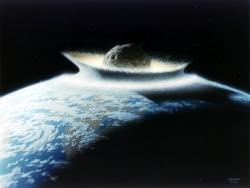Does this mean that, perhaps, we
can
go home again?
If an asteroid or comet impacted Earth, the resulting ejection of materials could contain life forms. According to a study published in the journal
Astrobiology
, these life forms could survive and then seed another planet or moon with life. Additionally, Earth could also be re-seeded with life by those same life forms.
Ah, there's no place like home.
If rock fragments containing embedded microorganisms were ejected into space, at least some of those organisms might survive and reseed Earth or seed another planetary surface able to support life. This scenario, which is called lithopanspermia was examined in studies called systematic shock recovery experiments designed to simulate this type of situation where microorganisms are transported between planets via meteorites.
The researchers sandwiched dry layers of three kinds of biological test ingredients, including bacterial endospores, endolithic cyanobacteria, and epilithic lichens, into rocks analogous to rocks from Mars. They then simulated the shock pressures Martian meteorites experienced when they were ejected from Mars and determined the ability of the organisms to survive the harsh conditions.
The organisms are hardy examples of microbes that can withstand extreme environmental stress and represent potential 'hitchhikers' within impact-ejected rocks.
"Given that impacts have occurred on planetary bodies throughout the history of our solar system," says Sherry L. Cady, PhD, Associate Professor in the Department of Geology at Portland State University, "the hypothesis that life in rock could have been transferred between planets at different times during the past 3.5 billion years is plausible."
And not only is it plausible that Mars rocks could be transferred to Earth and vice versa, but ejected rocks from Earth could possibly return and land back on their home planet. Given the contemplation of the destruction of life on Earth, it's somewhat comforting to think that we could perhaps start over again from our own ingredients.
Original News Source: Astrobiology Press Release
 Universe Today
Universe Today
